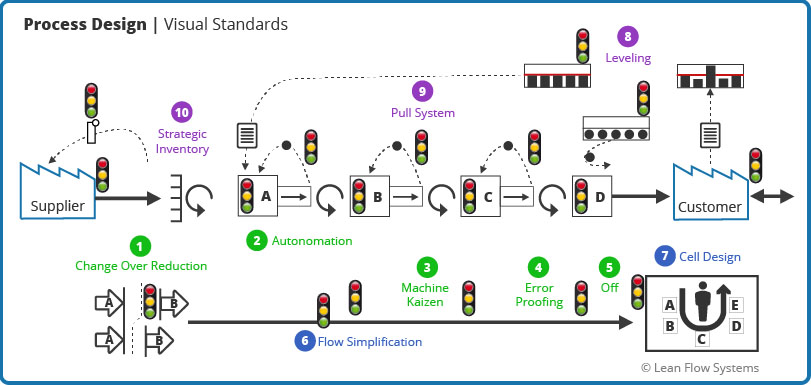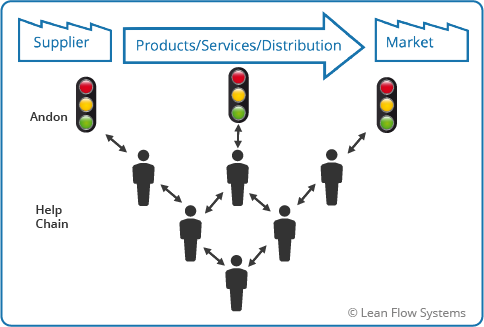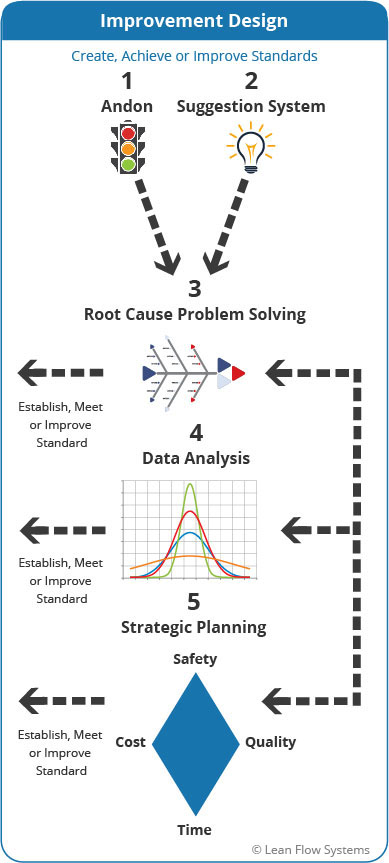
Lean Flow Systems improve businesses by designing operations and developing people to achieve superior performance in selection, time, cost, quality and safety.
Our expertise spans many industries:
- Manufacturing
- eRetail
- Supply Chain
- Health Care
- Customer Service
We have the vision to design great operations, the heart to engage your team and the grit to drive continuous improvement.
LFS Approach
Our clients have great trust in us because we approach them with an open mind and a passion to deliver extreme value. We merge the best ideas of the Toyota Production System, Six Sigma, and Data Analytics to create business systems that develop people, foster great teamwork and fast flow products and services. There are four elements to this approach:
Set the Vision – System Design. Draw up an operating blueprint to deliver superior performance.
Show Heart – Organization Design. Nurture a respectful, collaborative environment.
Have Grit – Improvement Design. Teach a disciplined approach to problem-solving using the scientific method.
Apply Rigor – Process Design. Work at the detailed process level to eliminate waste, unevenness, and overburden.
System Design

End to End Expertise
LFS improves the entire end-to-end business system. The first step is understanding your strategy and assessing your markets, products and services. Second, a deep dive data analysis of your supply chain is done, including a rigorous current state of the value stream. Finally, a target state is developed that reduces complexity, eliminates waste and delivers superior performance in time, cost, quality and safety.
LFS’s work powers clients to dominate key markets and deliver excellent financial results.
Holistic Approach
A holistic approach ensures world class solutions are built that optimize the entire business:
Strategy: Solutions improve all areas of the business, achieving world class results.
Suppliers: Set up to drive low cost, high speed delivery.
Processes: Link together to eliminate waste and drive fast, efficient flow of products and services.
Distribution: Designed to minimize distribution costs and provide customers with rapid, flexible delivery.
Market: Customer expectations are well understood and an operating system built to exceed those expectations in selection, price and lead time.
Process Design

Deep Dive
LFS dives deep into process design and develops model areas to teach the team, drive rapid results and construct the target system. Waste is eliminated and a standards-based culture developed. Metric dashboards and visual indicators of process status are installed to measure performance to standard and provide feedback to the team when there are variations from targets.
Processes are built that reveal problems close in time and space to their occurrence and engage the entire team in rapid problem solving.
Process Transformation
There are ten major tools used when conducting a rigorous process design deep dive:
Change Over Reduction
Autonomation
Machine Kaizen
Error Proofing
Total Process Efficiency
Flow Simplification
Cell Design
Leveling
Pull System
Strategic Inventory
This suite of tools addresses machine/equipment design, process flow, workplace layout, employee work standards and demand scheduling.
Organization Design

Unleashing People Power
Honest, frequent and accurate communication is the glue to building a culture of continuous improvement. LFS collaborates at all levels of the company to develop processes that connect people, establish trust and build fellowship. We help people grow by teaching them how to better solve problems to root cause.
The LFS approach is grounded in the Toyota Production System (TPS) and is summarized by the following quote from Taiichi Ohno, father of TPS:
Teamwork is Everything
“In modern industry, harmony among people in a group is in greater demand than the art of individual craftsmanship.”
-Taiichi Ohno, “Toyota Production System”
High Performance Learning
The organization is engineered as a Help Chain to rapidly deploy skilled people to the value stream when needed. The servant leader model is espoused and taught.
Clear visual indicators, called Andons, are built into the process and communicate problems quickly to the team. The support organization is designed to respond to these triggers and solve problems in real time where possible. Andon response time and problem resolution time are measured and tracked to assess the team’s problem solving capacity.
Improvement Design

The Pursuit of Excellence
LFS takes a systematic approach to problem-solving. The goal is to make problems clear to employees at all levels of the company and to facilitate teamwork. A problem is defined as one of the following:
No standard exists
A standard exists but is not being met
A standard exists, is being met, but can be improved (e.g. there is waste inherent in the standard)
LFS helps clients improve their businesses by eliminating waste (muda), unevenness (mura), and overburden (muri) through the execution of the problem-solving process.
Scientific Method
The improvement process is triggered in two ways:
- Andon signal indicates that a process is not meeting the performance standard.
- Suggestions and ideas to improve the process.
The Root Cause Problem Solving process is launched to solve problems quickly using methods like the “Five Whys” or the Ishikawa (Fishbone) Diagram. The scientific method of problem solving is used to ensure a disciplined approch: Problem, Cause, Solution, Action, Measure.
If the team cannot solve the problem then more advanced Data Analysis tools are employed.
Strategic Planning is linked to ensure that product, process, engineering and capital decisions take into consideration the problems being triggered and suggestions of the team being made.





